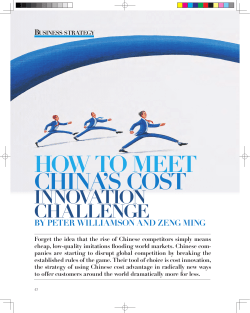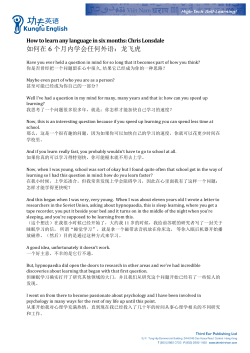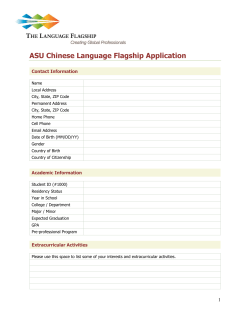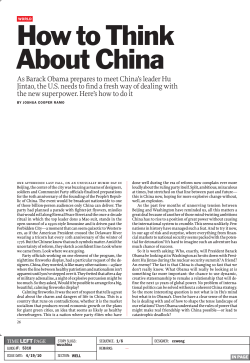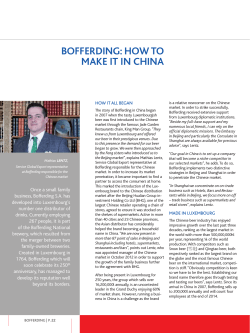
How to deal with China, the emerging super power offer
How to deal with China, the emerging super power Croatian businesses should act now to seize the vast opportunities on offer China poses no immediate threat for Croatian businesses, at least not in the short term. But as the Chinese philosopher Confucius said some 2500 years ago, people who don't show an interest in things far away will face trouble close to home. The next few years will be decisive and Croatian companies should use the time now to broaden their horizons, paying special attention to developments taking place in China, the emerging super power. Croatian companies should try to learn from the success stories arising as a result of China's rapid economic development and examine how other countries have acted when dealing with China. Croatian companies should aim to develop their businesses so that they can gain a sustainable competitive position. This will enable them to use opportunities arising out of China to their advantage and also empower them to shape developments within Croatia themselves. China today When speaking of China, it is important not to think of one single, homogeneous region. Grasping China's diversity may well help Croatian investors unlock attractive investment opportunities in the world's most dynamic country. A large and richly diverse growth region China is a huge and very heterogeneous country. It is nearly two-and-a-half times bigger than the current European Union, stretching over several climatic zones, from tropical to polar. Its inhabitants have different habits and needs. A gigantic gap exists between rural and urban areas in terms of development, purchasing power (roughly EUR 250 annually in rural areas, EUR 2,400 in Shanghai), and technology use. More than 50 dialects are spoken in China and only 90 million of China's 1.3 billion residents speak Mandarin as their mother tongue. The country has 31 provinces, each with their own laws and directives. Already one of the biggest global economies China overtook France in 2005 to became the fifth-largest economy in the world. With a GDP of EUR 1,800 billion in 2005, China easily outperforms the biggest economies in Central and Eastern Europe (CEE), Russia and Poland, with GDPs of EUR 597 billion and EUR 238 billion respectively. This year China is set to knock the UK from its position as fourth-largest economy in the word. China's currently low GDP per capita of EUR 1,507 (Croatia has for comparison GDP per capita of EUR 6,720) reflects a low average standard of living, but it also points to the country's huge untapped growth potential. Many products will be able to storm this huge market. The overall rate of economic growth in Central and Eastern Europe was 5.4 percent in 2005 – well ahead of the 1.4 percent expansion witnessed by the EU in the same year. The Baltic states of Lithuania, Latvia and Estonia stand out with average growth of 8.8 percent. Russia (5.7 percent) and the Slovak Republic (5.6 percent) are roughly in line with the CEE average. Croatia grew 4.0 percent in 2005 and has notched up an average economic growth rate of 4.6 percent annually since 2000. In chart 1, each CEE country is compared with China. For the past 25 years, China has grown phenomenally, with average annual growth of 9 percent. More importantly, this growth is stable and continuous. How Central and Eastern European countries compare with China GDP per capita [EUR] 14,000 Slovenia 12,000 Hungary 10,000 Poland 8,000 Slovakia 6,000 Czech Republic Estonia Lithuania Croatia 4,000 2,000 Ukraine 0 0 2.5 Latvia Russia Romania 3.5 China Serbia & Bulgaria Montenegro 4.5 5.5 6.5 7.5 8.5 9.5 GDP growth [%] 10.5 Number of inhabitants 2005 data Source: Bank Austria Creditanstalt, Roland Berger Strategy Consultants Chart 1: How Central and Eastern European countries compare with China China establishes itself on the world stage Unexpected results came to light in a survey recently conducted at high schools in the US. When school directors were asked which languages they would like to see added to the teaching program, 50 suggested Russian, 175 Japanese, 240 Italian and – unbelievably – 2,400 directors wanted Chinese. 2 China is making the most of the international interest in its country. It is actively promoting its presence and image on the international arena. Following a Chinese government order, a global network of Chinese Cultural Centers currently is being set up based on the German Goethe-Institut, the French Alliance francaise and the Spanish Instituto Cervantes. A global network of Chinese technology parks is also being created. The newest park, currently in construction, is located in Vienna. The Chinese have decided that Vienna will be the place from which to gain access to Central and Eastern Europe markets. Vienna was also chosen to ensure a systematic technology transfer from Austrian high tech companies to their Chinese counterparts. This is the first Chinese technology park located in Europe – others exist in the US, Russia, Singapore and the UK. A further reason why Vienna was chosen for the new Chinese technology park is its geographical closeness to two important auto-clusters located in Styria and in Slovakia. How are big countries dealing with this emerging super power? The US, for instance, announced a shift in its diplomatic strategy in 2005. It plans to focus more strongly on new growth regions in the world, meaning mainly Asia but also to a smaller degree, CEE. As a consequence of the shift, the US will reduce the number of its diplomatic posts in Western Europe and build up its presence in the world's new growth regions. In past years, Chinese companies were mostly present on foreign markets via export only. Today, however, there is a clear trend showing that Chinese companies are increasingly looking for acquisitions, joint ventures and own sales and marketing offices abroad. Up to now, the US has been the main target for Chinese investments, accounting for roughly 12 percent of total Chinese FDI. It is followed by Australia, with 10 percent. Of European countries, Spain garners the most Chinese FDI, with 2.5 percent. Germany, which receives 2.0 percent of Chinese FDI, is the second-largest European recipient. Several factors indicate that China's internationalization will grow rapidly in the future: • Low cost production structures are prevailing • It has a growing home market – emergence of a significant-sized middle class with Western European purchasing power • An established supplier base already exists in China for international first mover companies • There's an availability of investment capital: China is a global leader when it comes to FDI, receiving EUR 72 billion in 2005 • Chinese companies are following an expansion strategy • Multinational corporations are increasingly establishing R&D centers in China (currently more than 130) China does its homework: The new five-year plan 3 While most political leaders are well-known for making vague statements in public, Chinese Premier Wen Jiabao recently showed that he doesn't mince words. He sounded like a CEO preparing his top management for tough restructuring when he presented China's new five-year plan to the National People's Congress earlier this year. China has shifted its efforts from "growth at all costs" to building a sustainable and balanced economy. The economic and social objectives of the new plan are particularly interesting for European corporations doing, or planning to do, business in China. China's determination to become a technology leader is a key element of the new five-year plan, which recommends that R&D investments be increased by about 20 percent each year. It already has an army of well trained graduates. In 2004, the number of engineers graduating in China was ten times greater than in Germany (380,000 in China vs. 36,000 in Germany). Even when only one Chinese engineering graduate in ten leaves university to work for a global company, this exceeds the total amount of graduating German engineers. As China moves up the technology ladder, larger amounts of international venture capital is pumped into the country. The influx of venture capital has more than tripled over the past two years. The strategic context of China for Croatia Looking at chart 1 we see that Croatia, with a GDP per capita of EUR 6,720, is about 4.5 times wealthier than China on average. However, as Croatia's GDP growth is 4.0 percent, it is growing at half the speed of China. Trade with China is currently undeveloped, accounting for only 0.1 percent of total exports and 5 percent of total imports in 2005. The trade balance was also negative in 2005, with EUR 711 million. Over the past three years, however, trade volume has grown rapidly, with 38 percent. But the focus is mainly on imports. Detailed figures are shown in chart 2. 4 Chinese-Croatian trade relations are balanced in favor or China Croatia's trade with China (2003-2005) [EUR m] 800 CAGR 39 % 718.0 Imports 700 POTENTIAL Future export opportunities (according to China's new five-year plan): • Water 600 527.5 • Pharmaceuticals and healthcare 500 400 • Special chemicals 373.4 • Professional services 300 200 100 • Energy CAGR 36 % 3.9 6.0 7.3 2003 2004 2005 0 • Environmental technology Exports • High-end machinery • Petrochemicals Source: CROSTAT, Roland Berger "think:act CONTENT" study Chart 2: Chinese-Croatian trade relations are balanced in favor or China 5 Three issues need to be considered When analyzing the strategic context of China for Croatia three issues should be considered: • • • China as a consumer market China as a foreign investor and exporter Experience of other countries in their dealings with China China as consumer market As a consumer market, China will have vast potential for decades to come. All eyes are focused on the emergence of a middle class. Even when moderate economic growth forecasts are used as a base, there could be 500 million middle class consumers with European purchasing levels by 2025. To ensure that they benefit from this development, Croatian companies should strive more actively to find local partners to distribute their products in China. The fact that most Chinese companies are still small in European terms is a plus point for Croatian companies, as it makes establishing business relations easier. Once business relations flourish, the likelihood that Chinese consumers will come to Croatia increases. Currently, Croatia is devoid of tourists from China. This will change. The potential to win high-value tourists, especially in the shoulder seasons, is high. The aim shouldn't be to attract mass tourists from China, but rather the upper middle class. Fifteen years from now, we'll probably be scrambling to find waiters who can speak Chinese. China as a foreign investor and exporter Croatia and China are not strong trading partners. This is a terrible sign, reflecting the Croatian economy's lack of real international punch. It also reveals China's lack of interest in Croatia. Yet the situation is not completely bleak. Companies in CEE have time to develop their own strategy for dealing with this emerging super power without being immediately threatened by it. The attractiveness of Croatia as an investment location for Chinese companies has been low to date. Compared to other CEE countries, Croatia does not have any significant competitive advantages: the size of the consumer market is low and it failed to establish itself as a hub for the entire South Eastern European region (Slovenia to Bulgaria), which has a consumer market of more than 30 million. In addition, in international comparison there is no outstanding high tech industry or highly innovative companies. From the investor's point of view, Croatia will not be a target for Chinese companies – not even in the near future – as it is neither a production or sourcing location nor does it have a large consumer market. 6 This is bad news for Croatia. China-made products are increasingly swamping the Croatian market, but investments will not flow into Croatia. Experience of other countries in their dealings with China Between 2001 and 2004, China hype was prevalent. During these years, the top agenda point of every leading Western European and US company was how to gain access to this huge market. Issues such as optimizing the global footprint to China (i.e., transferring production capacities) were all the rage during the first wave. In the second wave of the hype, which we are currently in, companies are concerned with how they can place their own products in China's huge and booming consumer market. While outsourcing and investing in China dominated headlines in the first wave from 2001 to 2004, these days companies are now concerned with consolidation and excellence. Short wrap up of business threats and opportunities Sometimes the emergence of a global super-power effects industries, whether people want it or not. That's why it is better for companies to assess developments and their own position in some kind of scenario planning. This helps them to actively develop action plans that can let them grasp opportunities when they emerge and avoid unnecessary disadvantages. The following business threats exist for Croatia's businesses: • • • A commodity product offensive due to cheap Chinese labor force. The effects have already been seen in the textile sector after quotas for textile and clothing were removed a year ago Increasing innovation and high-tech drain from Western countries to Chinese companies. This, combined with the Chinese government's R&D focus and the strong influx of multinational R&D facilities, poses a threat to Croatian companies, especially for those that aren't able to establish and maintain a technology advantage Strong Chinese political lobby and global might: Croatia should selectively establish good ties with the Chinese government and institutions. It should try to seize opportunities in niche areas Considering the possible business opportunities that China offers, Croatian companies have no choice but to enter China's vast and strongly growing market. Large-scale infrastructure projects are under way such as the Olympics in Beijing in 2008 and the Shanghai World Expo in 2010. The 2008 Olympics have an estimated investment volume of EUR 30 billion. Future export opportunities, according to China's new five-year plan, will be found in the following sectors: water, pharmaceuticals and healthcare, special chemicals, professional services, energy, environmental technology, high-end machinery and petrochemicals. 7 Croatia needs to improve its economic footing Roland Berger Strategy Consultants has developed a framework for companies that want to use the emergence of China as a new global player to their advantage. The framework is supported by work completed with clients around the world who have proactively faced the Chinese challenge. We call this approach the Four Element Strategy, which we have adapted for Croatia. Croatian companies threatened by Chinese companies should consider four strategic elements, which are shown in the chart below: enhance your skills to become a best practice company; use your home advantage to win customers in your own market; go into offensive and threaten Chinese players on their home market; optimize your own value chain globally to remain operationally competitive. Croatian companies are recommended to follow the Four Element Strategy when dealing with China Four element strategy 1 2 Enhance your skills > Develop your strategy > Establish global best practice operational efficiency > Build up critical size fast 3 Use your home advantage > Meet local/regional and European consumer needs > Build up a stable European network 4 Go into the offensive > Weaken the competition in its home market > Use acquisition possibilities in China as long as they exist Optimize your global footprint > Optimize your global/ international value chain to remain competitive Source: Roland Berger Strategy Consultants Chart 3: Croatian companies are recommended to follow the Four Element Strategy when dealing with China 1. Enhance your skills – become best practice 8 Before considering any international activities, there is a set of measures that all companies need to tackle, improving themselves to gain best practice level, preferably on an international level: • • • • • • Enhance management skills Increase the number of globally savvy employees (mindset, experience abroad) Define a clear strategy, and execute it quickly and decisively Make innovation a top priority – develop products that are high flyers in world markets Use own creative potential to design world class products Enhance marketing and especially sales skills These measures are the basic ground work for all companies. How well companies execute excellence, however, varies between companies and from country to country. Croatian companies often lag in this respect. Import quote regulations and governmental restrictions will not be able to protect the Croatian economy in a globalized and highly networked world. Only best-in-class performance – strategically and operationally – will assure the independent survival of Croatian companies and will be able to increase the Croatian life standard. 2. Use your home advantage Top managers and supervisory board members should keep Chinese development in mind. Yet immediate challenges and opportunities are closer – in the big, mostly untouched markets of South Eastern Europe and markets even further east such as Ukraine, Turkey and Russia. These markets provide Croatian companies with an ideal playground to learn the necessary skills and tools for dealing with international competition. They also allow Croatian companies to reach a critical international size that will let them start doing business successfully in China in a second wave. Unfortunately, bilateral trade relations between China and Croatia are currently close to zero. Croatian investments in, and exports to, China are almost non-existing and prevent companies from capturing vast market opportunities. 3. Go into the offensive In the sixth century BC, the Chinese general Sun Tsu recommended in his strategy master piece "The Art of War" that you should proactively anticipate your opponent instead of being driven by him. Sun Tsu believed that wise generals feed their troops from the ground of their opponents. For Croatian companies, this means actively searching for acquisition targets or joint ventures in China while there are still attractive market opportunities. 4. Optimize your global footprint Optimizing your global footprint is the final element within the Four Element Strategy. At this stage, companies need to optimize the own global/international value chain to remain competitive in a global context. 9
© Copyright 2025

